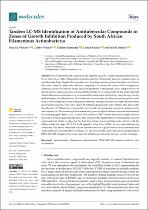| dc.contributor.author | Watson, Daniel J. | |
| dc.contributor.author | Wiesner, Lubbe | |
| dc.contributor.author | Beukes, Denzil | |
| dc.date.accessioned | 2023-06-27T08:40:37Z | |
| dc.date.available | 2023-06-27T08:40:37Z | |
| dc.date.issued | 2023 | |
| dc.identifier.citation | Watson, D. J. et al. (2023). Tandem lc-ms identification of antitubercular compounds in zones of growth inhibition produced by South African filamentous actinobacteria. Molecules, 28(11), 4276. https://doi.org/10.3390/molecules28114276 | en_US |
| dc.identifier.issn | 1420-3049 | |
| dc.identifier.uri | https://doi.org/10.3390/molecules28114276 | |
| dc.identifier.uri | http://hdl.handle.net/10566/9163 | |
| dc.description.abstract | Novel antitubercular compounds are urgently needed to combat drug-resistant Mycobacterium
tuberculosis (Mtb). Filamentous actinobacteria have historically been an excellent source of
antitubercular drugs. Despite this, drug discovery from these microorganisms has fallen out of favour
due to the continual rediscovery of known compounds. To increase the chance of discovering novel
antibiotics, biodiverse and rare strains should be prioritised. Subsequently, active samples need to be
dereplicated as early as possible to focus efforts on truly novel compounds. In this study, 42 South
African filamentous actinobacteria were screened for antimycobacterial activity using the agar overlay
method against the Mtb indicator Mycolicibacterium aurum under six different nutrient growth conditions.
Known compounds were subsequently identified through extraction and high-resolution mass
spectrometric analysis of the zones of growth inhibition produced by active strains. This allowed the
dereplication of 15 hits from six strains that were found to be producing puromycin, actinomycin D
and valinomycin. | en_US |
| dc.language.iso | en | en_US |
| dc.publisher | MDPI | en_US |
| dc.subject | Antitubercular | en_US |
| dc.subject | Pharmaceuticals | en_US |
| dc.subject | Mycobacterium tuberculosis | en_US |
| dc.subject | South Africa | en_US |
| dc.subject | Covid-19 | en_US |
| dc.subject | Public health | en_US |
| dc.title | Tandem lc-ms identification of antitubercular compounds in zones of growth inhibition produced by South African filamentous actinobacteria | en_US |
| dc.type | Article | en_US |

